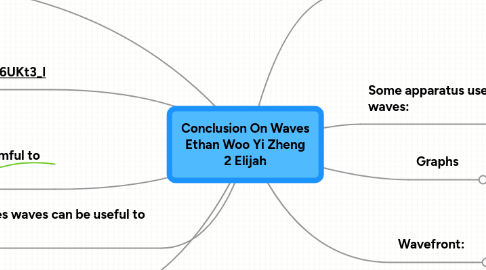Conclusion On Waves Ethan Woo Yi Zheng 2 Elijah
by Ethan Woo Yi Zheng


1. Terms used:
1.1. Wavelength λ
1.2. Period(t) unit: second
1.3. Amplitude a
1.4. Frequency(f) unit: hertz(Hz)
1.5. Velocity(v) formula: velocity= frequency x wavelength
2. Formulas:
2.1. T=1/f
2.2. f=1/T
2.3. v(velocity)= fλ
3. Video on waves: http://www.youtube.com/watch?feature=player_embedded&v=c38H6UKt3_I
4. Some waves can be harmful to people
4.1. Some waves can cause harm to people such as ultraviolet waves which can cause skin cancer
5. Sometimes waves can be useful to humans:
5.1. Water waves can be used to power hydroelectric dams to bring power to many places in the world
6. What are Waves?
6.1. A wave can be defined as the propagation of periodic disturbances(deviations from a state of rest or equilibrium, from one region to another, without the transfer of any material medium.
6.2. There are transverse and longitudinal waves
6.2.1. Transverse waves have their oscillations move perpendicular to the transfer of energy
6.2.2. Longitudinal waves have their oscillations moving parallel to the transfer of energy.
7. Wavefront:
7.1. A wavefront is an imaginary line or surface that joins all adjacent points which have the same phase of vibration on the wave
7.1.1. Phase of Vibration: Any two points on a wave are said to be in phase when they have completed identical fractions of their periodic motion.
